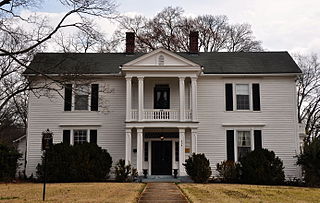
McMinnville is the largest city in and the county seat of Warren County, Tennessee, United States. The population was 13,605 at the 2010 census. It was named for Governor Joseph McMinn.

The E. H. Crump House is a historic house in Memphis, Tennessee, U.S.. It was built in 1909 for E. H. Crump, who went on to serve as the mayor of Memphis from 1910 to 1915. It was designed in the Colonial Revival architectural style, with Doric columns. It has been listed on the National Register of Historic Places since December 26, 1979.

The Bradford-Maydwell House is a historic house in Memphis, Tennessee, U.S.. The plot of land was acquired by W. C. Bradford in 1853; by 1860, it belonged to James Maydwell. The construction of the house began in 1859. It was designed both in the Federal and Italianate architectural style. It has been listed on the National Register of Historic Places since December 26, 1979.

The Fite-Fessenden House is a historic house in Lebanon, Tennessee, U.S.. It is now home to the Wilson County Museum.

The Frierson-Coble House is a historic house in Shelbyville, Tennessee, U.S.. It was built in 1835 for Erwin J. Frierson, who was trained as a lawyer by James K. Polk, who went on to serve as the 11th President of the United States from 1845 to 1849. Frierson served as a member of the Tennessee House of Representatives in 1845. In 1888, the house was purchased by Dr Neely Coble, a physician; it was later inherited by his son, Thomas Coble, also a physician. By the 1980s, it still belonged to the Coble family. It has been listed on the National Register of Historic Places since April 12, 1982.

The Absalom Lowe Landis House, also known as Beech Hall, is a historic house in Normandy, Tennessee, U.S..

The Nathan Bedford Forrest Boyhood Home is a historic log house in Chapel Hill, Tennessee, U.S.. It was the childhood home of Confederate General and Ku Klux Klan leader Nathan Bedford Forrest from 1830 to 1833. It is owned by the Sons of Confederate Veterans.
Ewing Farm is a historic farmhouse three miles away from Lewisburg, Tennessee, US.

The Joe Chase Adams House, also known as The Ledges, is a historic house in Lewisburg, Tennessee, U.S.. It was built in 1900 for Joe Chase Adams, a dry goods merchant who served as the mayor of Lewisburg. It was designed in the Queen Anne architectural style. Adams's granddaughter, Mrs. Ernest Wheeler Henegar, Sr. purchased the house in 1943; she subsequently hired Bill Knox to redesign the interiors. It has been listed on the National Register of Historic Places since December 2, 1993.

Valley Farm is a historic mansion and stud farm in Cornersville, Tennessee, U.S..

Fitzpatrick House is a historic mansion in Mooresville, Tennessee, U.S..

The Sam Davis House is a historic house in Smyrna, Tennessee, U.S.. It is now a museum to the memory of Confederate soldier Sam Davis.

Idler's Retreat, also known as the Dillon-Tucker-Cheney House, is a historic house in Smyrna, Tennessee, U.S.. It was built circa 1865 by J. D. Dillon. In 1882, it was purchased by John F. Tucker, and renamed Tucker Place. It was designed in the Greek Revival and Italianate architectural styles. By the 1940s, it was inherited by Brainard Cheney's wife. The couple entertained other writers like Robert Penn Warren, Caroline Gordon, Flannery O'Connor and Allen Tate. The house was later inherited by Roy Neel, who served as the chief of staff to Vice President Al Gore. It has been listed on the National Register of Historic Places since May 19, 2004.

The Collier-Crichlow House is a historic house in Murfreesboro, Tennessee, U.S..

The Collier-Lane-Crichlow House is a historic house in Murfreesboro, Tennessee, U.S.. It was built circa 1850 for architect Sterling P. Jones, who designed in the Federal, Georgian and Greek Revival architectural styles. It was purchased by brothers Jessie A. Collier and Newton C. Collier in 1858. Four of Murfreesboro's mayors from the Collier-Crichlow family lived in the house: Ingram Collier, Newton B. Collier, James H. Crichlow Jr., and N. Collier Crichlow. It was restored by new homeowners in 1975. It has been listed on the National Register of Historic Places since August 23, 1978.

The Jarman Farm is a historic house in Lascassas, Tennessee, U.S.. It was built in 1850-1860 for Robert Hall Jarman, who owned 19 slaves by 1860. It was inherited by his son, Rufus E. Jarman, in 1884. It was later inherited by his granddaughter, who married Jack Penuel. The property includes several outbuildings and a cemetery. It has been listed on the National Register of Historic Places since July 6, 1987.
Henry Gibel was a Swiss-born American architect. He designed many buildings in Tennessee, some of which are listed on the National Register of Historic Places.
Asa Faulkner was an American businessman and politician. He served in the Tennessee House of Representatives and the Tennessee Senate.

Falcon Rest, also known as the Clay Faulkner House, is a historic house in Warren County, Tennessee. It was built in 1896-1897 for Clay Faulkner, the son of politician and mill owner Asa Faulkner, who lived at Falconhurst.















